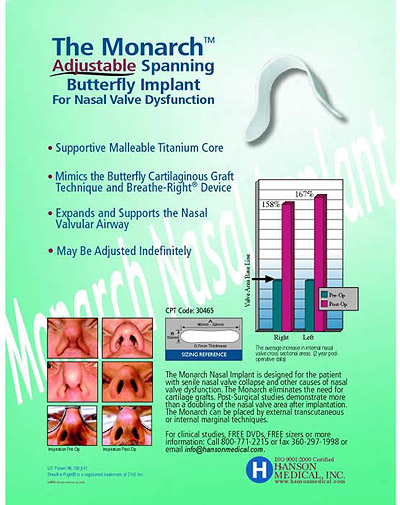 |

Dear physician: Thank you for your interest in the Monarch Nasal Implant. The Monarch has currently been in use for over 2 years and was designed to correct nasal valvular dysfunction both internal and external, static and dynamic.
The key to consistent success with the use of the Monarch is proper patient selection, strict adherence to recommended surgical techniques and careful post-operative management. Of the 45 implants the designer placed, there have been 4 failures, including 3 extrusions and one implant fracture. The extrusions have been due to initial procedural problems which have occurred within 2 months of the surgery. There have been no late extrusions. The one implant failure was due to patient over manipulation. |
As with any new device, there will be a bit of a learning curve with its use. Our goal is to shorten this curve so that your first and every subsequent implantation will be successful for both you and your patient. It is important to adhere to the following principles to ensure success:
- A thorough understanding and strict adherence to recommended implantation techniques and post-operative management as provided through Hanson Medical “PROCEDURAL GUIDELINES,” Monarch DVD’s and clinical studies.
- Regardless of the approach used the implant should always slide easily into the dissected pocket since any force could cause its disfigurement. The physician needs to ensure that the implant remained smooth and uniform after its placement. If not, it should be removed for re-contouring and replaced. Any irregularities will create pressure points which will significantly increase the risk of extrusion over time.
- When placed by an intranasal technique marginal incisions, not inter or transcartilagenous, are mandatory to create the proper pocket and allow the implant to be secured superior to the incision site. (Monarch DVD, Intranasal Technique).
- When the implant is placed transcutaneously, gentle dilation immediately after insertion is allowable (Monarch DVD, Transcutaneous Technique). However, with the intranasal technique the implant must not be left dilated after placement or expanded at any time during the first two weeks to avoid tenting of the soft tissue envelope. This would cause nasal disfigurement and increase the risk of extrusion. The implant should actually be slightly compressed immediately after insertion (Monarch DVD, Intranasal Technique) or at least conformed to the patient’s native pre-operative nasal configuration to prevent tissue tenting.
- When securing the implant after intranasal placement it should be slightly higher for internal nasal valve problems, and somewhat lower or further down into the ala for external nasal valve problems. The placement of the marginal incisions should correspond so that when the implant is secured, it will lie at least 2mm away from the closure. Careful placement of the securing bolsters, as described, is also critical.
- If the patient wears glasses the footplate of the glasses should not rest on the superior aspect of the implant to avoid erosion. If a pressure point does develop, they should be referred to their Optometrist for an adjustment as needed.
- Dysfunction of the nasal valve rarely presents as the sole contributor of the patient’s airway problems. Because of this, placement of the Monarch implant is frequently combined with other nasal airway procedures such as septoplasty, or turbinate reduction and billed separately with the appropriate -59 modifiers.
- For best results any preexisting allergy or sinus conditions should be diagnosed and concurrently managed.
Please report any problems with the Monarch to Hanson Medical, Inc. at
800-771-2215 or email address: erik@hansonmedical.com
|



